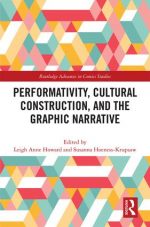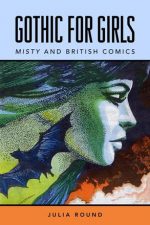Im Monitor werden in unregelmäßigen Abständen aktuelle Publikationen aus den letzten 6 Monaten vorgestellt, die für die Comicforschung relevant sein könnten. Die kurzen Ankündigungstexte dazu stammen von den jeweiligen Verlagsseiten. Haben Sie Anregungen oder Hinweise auf Neuerscheinungen, die übersehen worden sind und hier erwähnt werden sollten? Das Team freut sich über eine Mail an redaktion@comicgesellschaft.de.
→ Zu früheren Monitoren.
More Critical Approaches to Comics: Theories and Methods *
Matthew J. Smith, Matthew Brown und Randy Duncan (Hgs.)
Routledge
286 Seiten
September 2019
Verlagsseite
„In this comprehensive textbook, editors Matthew J. Brown, Randy Duncan, and Matthew J. Smith offer students a deeper understanding of the artistic and cultural significance of comic books and graphic novels by introducing key theories and critical methods for analyzing comics.
Each chapter explains and then demonstrates a critical method or approach, which students can then apply to interrogate and critique the meanings and forms of comic books, graphic novels, and other sequential art. Contributors introduce a wide range of critical perspectives on comics, including disability studies, parasocial relationships, scientific humanities, queer theory, linguistics, critical geography, philosophical aesthetics, historiography, and much more.
As a companion to the acclaimed Critical Approaches to Comics: Theories and Methods, this second volume features 19 fresh perspectives and serves as a stand-alone textbook in its own right. More Critical Approaches to Comics is a compelling classroom or research text for students and scholars interested in Comics Studies, Critical Theory, the Humanities, and beyond.“
Performativity, Cultural Construction, and the Graphic Narrative
Leigh Anne Howard und Susanna Hoeness-Krupsaw (Hgs.)
Routledge
264 Seiten
September 2019
Verlagsseite
„Performativity, Cultural Construction, and the Graphic Narrative draws on performance studies scholarship to understand the social impact of graphic novels and their sociopolitical function.
Addressing issues of race, gender, ethnicity, race, war, mental illness, and the environment, the volume encompasses the diversity and variety inherent in the graphic narrative medium. Informed by the scholarship of Dwight Conquergood and his model for performance praxis, this collection of essays makes links between these seemingly disparate areas of study to open new avenues of research for comics and graphic narratives. An international team of authors offer a detailed analysis of new and classical graphic texts from Britain, Iran, India, and Canada as well as the United States.
Performance, Social Construction and the Graphic Narrative draws on performance studies scholarship to understand the social impact of graphic novels and their sociopolitical function. Addressing issues of race, gender, ethnicity, race, war, mental illness, and the environment, the volume encompasses the diversity and variety inherent in the graphic narrative medium. This book will be of interest to students and scholars in the areas of communication, literature, comics studies, performance studies, sociology, languages, English, and gender studies, and anyone with an interest in deepening their acquaintance with and understanding of the potential of graphic narratives.“
Maskierte Helden: Zur Doppelidentität in Pulp-Novels und Superheldencomics
Aleta-Amirée von Holzen
Chronos
420 Seiten
September 2019
Verlagsseite
„Populäre Heldengestalten wie Zorro, Batman oder Spider-Man vollbringen ihre Taten in der Öffentlichkeit nur maskiert, verbergen aber in Zivil jeden Anschein von Heldentum. Mit diesem Geheimnis ermöglichen solche maskierten Helden in ihren Geschichten die vielfältige Thematisierung von Identitätsvorstellungen – kommt der Maske doch schon immer die Funktion zu, Identitätskategorien und -kategorisierungen zu hinterfragen. In den Spannungsfeldern der Maskerade zwischen Sein und Schein versuchen diese Figuren seriellen Erzählens immer wieder aufs Neue, die Balance zwischen Individualität und Konformität zu finden oder zu halten.
Was maskierte Helden ausmacht und wie solche Figuren zwischen Fragen nach dem ‹wahren› Ich und multiplen Selbsten oszillieren, zeigt dieses Buch in einem grossen zeitlichen Bogen über das gesamte 20. bis ins beginnende 21. Jahrhundert, in dem auch die Genese des maskierten Helden als Figurentypus nachgezeichnet wird. Weltbekannte Figuren wie Superman, weniger bekannte wie Daredevil, die Thunderbolts und The Shadow sowie eine Vielzahl fast vergessener Helden aus den US-amerikanischen Pulp-Novels und frühen Superheldencomics stehen dabei im Fokus.“
Only at Comic-Con: Hollywood, Fans, and the Limits of Exclusivity
Erin Hanna
Rutgers University Press
300 Seiten
September 2019
Verlagsseite
„When the San Diego Comic-Con was founded in 1970, it provided an exclusive space where fans, dealers, collectors, and industry professionals could come together to celebrate their love of comics and popular culture. In the decades since, Comic-Con has grown in size and scope, attracting hundreds of thousands of fans each summer and increased attention from the media industries, especially Hollywood, which uses the convention’s exclusivity to spread promotional hype far and wide. What made the San Diego Comic-Con a Hollywood destination? How does the industry’s presence at Comic-Con shape our ideas about what it means to be a fan? And what can this single event tell us about the relationship between media industries and their fans, past and present? Only at Comic-Con answers these questions and more as it examines the connection between exclusivity and the proliferation of media industry promotion at the longest-running comic convention in North America.“
Gothic for Girls: Misty and British Comic Books
Julia Round
University Press of Mississippi
358 Seiten
Oktober 2019
Verlagsseite
„Today fans still remember and love the British girls’ comic Misty for its bold visuals and narrative complexities. Yet its unique history has drawn little critical attention. Bridging this scholarly gap, Julia Round presents a comprehensive cultural history and detailed discussion of the comic, preserving both the inception and development of this important publication as well as its stories.
Misty ran for 101 issues as a stand-alone publication between 1978 and 1980 and then four more years as part of Tammy. It was a hugely successful anthology comic containing one-shot and serialized stories of supernatural horror and fantasy aimed at girls and young women and featuring work by writers and artists who dominated British comics such as Pat Mills, Malcolm Shaw, and John Armstrong, as well as celebrated European artists. To this day, Misty remains notable for its daring and sophisticated stories, strong female characters, innovative page layouts, and big visuals.
In the first book on this topic, Round closely analyzes Misty’s content, including its creation and production, its cultural and historical context, key influences, and the comic itself. Largely based on Round’s own archival research, the study also draws on interviews with many of the key creators involved in this comic, including Pat Mills, Wilf Prigmore, and its art editorial team Jack Cunningham and Ted Andrews, who have never previously spoken about their work. Richly illustrated with previously unpublished photos, scripts, and letters, this book uses Misty as a lens to explore the use of Gothic themes and symbols in girls’ comics and other media. It surveys existing work on childhood and Gothic and offers a working definition of Gothic for Girls, a subgenre which challenges and instructs readers in a number of ways.“
*Die ComFor-Redaktion bedauert den Mangel an Diversität in dieser Publikation. Wir sind bestrebt, möglichst neutral über das Feld der Comicforschung in all seiner Breite zu informieren und redaktionelle Selektionsprozesse auf ein Minimum zu beschränken. Gleichzeitig sind wir uns jedoch auch der problematischen Strukturen des Wissenschaftsbetriebs bewusst, die häufig dazu führen, dass insbesondere Comicforscherinnen sowie jene mit marginalisierten Identitäten weniger sichtbar sind. Wir wissen, dass dieses Ungleichgewicht oft nicht der Intention der Herausgeber_innen / Veranstalter_innen entspricht und möchten dies auch nicht unterstellen, wollen aber dennoch darauf aufmerksam machen, um ein Bewusstsein für dieses Problem zu schaffen.




